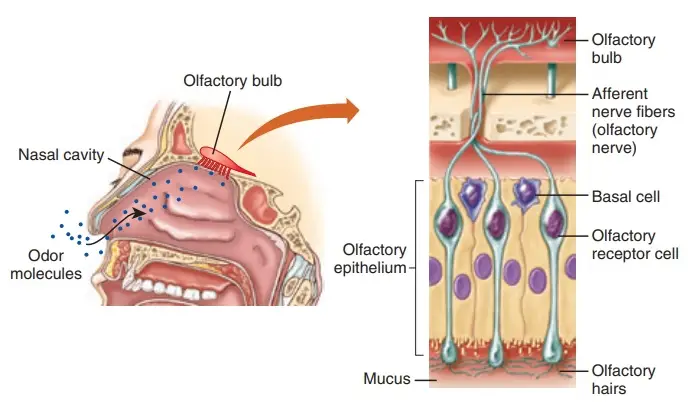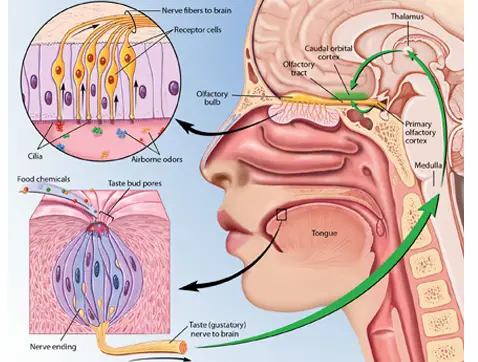The human body is equipped with a remarkable set of sensory receptors that play crucial roles in interpreting the environment. Among these, gustatory and olfactory receptors are fundamental in how we perceive tastes and smells. These receptors not only enhance our sensory experiences but also significantly influence our behavior and choices in daily life.
Gustatory receptors, located on the taste buds of the tongue, detect and respond to different taste stimuli such as sweet, salty, bitter, sour, and umami. Olfactory receptors, found in the lining of the nasal cavity, identify a vast array of volatile compounds, translating them into the scents and aromas we recognize. The key difference between these two types of receptors lies in their roles and mechanisms: gustatory receptors are primarily responsible for taste, while olfactory receptors are focused on smell.
This sensory processing is not just about detecting stimuli; it’s about creating a comprehensive understanding of what those stimuli mean. For example, the smell of food can trigger salivation, or the taste of something bitter can cause a reflexive reaction to spit it out. These responses are deeply integrated into our survival instincts, aiding in food selection and avoiding harmful substances.

Gustatory Receptors Overview
Definition and Function
Gustatory receptors, commonly referred to as taste receptors, are specialized sensory cells located primarily on the tongue. These receptors are responsible for detecting and interpreting the five basic taste types: sweet, sour, salty, bitter, and umami. Their primary function is to aid in identifying safe and nutritious food, as well as substances that might be harmful and should be avoided.
Location and Structure
The structure of gustatory receptors is complex. They are housed within taste buds primarily found on the tongue, but also on the soft palate, pharynx, and epiglottis. Each taste bud consists of 50 to 100 specialized epithelial cells with microvilli — tiny hair-like structures that protrude through an opening in the taste bud called the taste pore. These microvilli are the sites where chemical interactions occur with substances consumed, initiating the taste perception process.
Types of Tastes Detected
Each gustatory receptor is tuned to one of the five basic tastes:
- Sweet: Generally associated with energy-rich foods.
- Sour: Typically indicates acidity which might suggest spoilage but can also be a characteristic of ripe fruits.
- Salty: Essential for maintaining physiological processes.
- Bitter: Often a natural warning sign for toxins.
- Umami: Indicates the presence of amino acids, which are building blocks of protein.
Olfactory Receptors Overview
Definition and Purpose
Olfactory receptors are part of the olfactory system and are key to our sense of smell. These receptors detect odorous molecules and volatile substances, translating them into signals that the brain interprets as smell. The primary purpose of olfactory receptors is not just to help distinguish thousands of different smells but also to warn against dangers such as smoke or spoiled food.
Location and Anatomy
Olfactory receptors are located in a small patch of tissue high inside the nasal cavity. This area, known as the olfactory epithelium, contains millions of olfactory receptor neurons. These neurons have odorous molecule-binding sites on cilia, which are fine, hair-like structures extending from the cell into the mucus covering the epithelium.
Mechanism of Scent Detection
The process of scent detection begins when odor molecules dissolve in the mucus of the nasal cavity and bind to these receptors. Each olfactory neuron expresses only one type of olfactory receptor and sends electrical signals directly to the olfactory bulb in the brain. This part of the brain processes the signals into what we perceive as smells.

Key Differences
Structural Variations
While gustatory and olfactory receptors both detect chemicals, they vary significantly in their structure:
- Gustatory receptors are grouped in taste buds and detect chemicals dissolved in saliva.
- Olfactory receptors are spread across the olfactory epithelium and detect airborne chemicals.
Sensory Processes
The sensory processes also differ:
- Taste receptors translate chemical stimuli into taste through direct contact.
- Smell receptors detect airborne molecules, which must be dissolved in the nasal mucus before detection.
Role in Flavor Perception
The integration of input from both gustatory and olfactory receptors gives rise to the perception of flavor. This complex process allows individuals to discern flavors more intricately than through taste or smell alone. For instance, while you can taste the sweetness of an apple, it’s the smell that provides the distinctive flavor nuances.

Similarities
Molecular Interaction
Both gustatory and olfactory receptors function through molecular interactions. These receptors bind to specific molecules present in food and the environment, initiating a chain of biochemical events that result in taste and smell sensations. This binding process is crucial for identifying and differentiating between thousands of different flavors and scents.
Contribution to Gastrointestinal Responses
Gustatory and olfactory receptors both play significant roles in gastrointestinal responses. When activated, these receptors stimulate various digestive processes, which include:
- Saliva production to aid in digestion.
- Release of digestive enzymes from the pancreas.
- Modulation of gut motility to optimize digestion and absorption of nutrients.
These responses are essential for maintaining efficient digestion and overall gut health.
Neural Pathways Involved
The neural pathways involved in taste and smell are complex and highly integrated. Both types of receptors send signals to the brain via distinct pathways:
- Taste signals are processed primarily in the gustatory cortex.
- Smell signals travel to the olfactory bulb and then to other brain regions including the limbic system.
Despite their different paths, these signals often converge, especially in regions involved in memory and emotion, highlighting their interconnected roles in sensory perception.
Impact on Human Experience
Influence on Food Choices
The influence of gustatory and olfactory receptors on food choices is profound. They help determine what foods we prefer or dislike based on past experiences and genetic factors. For instance, a pleasant smell can make us more likely to eat a particular food, while a bad taste might deter us from eating it again.
Role in Memory and Emotion
These receptors significantly affect memory and emotion. Scents, in particular, can evoke strong memories and feelings. The smell of freshly baked cookies might remind someone of their grandmother’s house, or the taste of a specific spice might bring back memories of a favorite holiday.
Effects on Nutritional Health
Both types of receptors are vital in maintaining nutritional health. They help monitor the intake of nutrients and the avoidance of toxins. People with impaired taste or smell may not be able to detect spoiled foods or may find eating less enjoyable, which can lead to nutritional deficiencies or eating disorders.
Research and Developments
Recent Studies on Receptor Genetics
Recent advancements in genetics have shed light on how variations in receptor genes affect our perception of taste and smell. Studies have identified specific genetic markers that influence receptor functions, explaining why some people may be more sensitive to certain tastes or smells than others.
Technological Advances in Sensory Enhancement
Technological innovations have led to significant improvements in sensory enhancement. These include:
- Development of electronic noses and tongues that mimic human sensory reception.
- Enhancements in flavor and fragrance production that cater to specific consumer preferences or health requirements.
Future Implications in Medicine and AI
The implications of advancements in receptor research extend into medicine and artificial intelligence (AI). In medicine, understanding these receptors better can lead to improved treatments for sensory disorders. In AI, mimicking human sensory systems could revolutionize how machines interact with their environments, leading to smarter and more intuitive technology.
Frequently Asked Questions
How do gustatory receptors work?
Gustatory receptors initiate the taste perception process when food molecules bind to these receptors. This interaction sends signals to the brain, which interprets them as distinct tastes, helping us to discern and enjoy different flavors in our food.
What types of cells are involved in olfactory reception?
Olfactory reception involves olfactory sensory neurons, which contain the receptors for smell. These neurons detect odor molecules inhaled through the nose and send corresponding signals to the brain, which are then perceived as different smells.
Can these receptors influence each other?
Yes, gustatory and olfactory receptors can influence each other significantly. The combined input from both types of receptors contributes to the flavor of food, which is why foods can taste bland when we have a blocked nose.
Are there any conditions that affect these receptors?
Conditions like anosmia (loss of smell) and ageusia (loss of taste) directly affect olfactory and gustatory receptors, respectively. These conditions can be temporary or permanent, significantly impacting a person’s quality of life.
How are these receptors studied?
Researchers study these receptors through various methods including genetic analysis, brain imaging techniques, and behavioral tests. These studies help in understanding how sensory information is processed and can lead to improvements in artificial flavoring and scent technologies.
Conclusion
The study of gustatory and olfactory receptors opens a window into the intricate world of sensory perception. By understanding the distinct and overlapping functions of these receptors, we gain insights into how deeply intertwined our sense of taste and smell are with our overall sensory experiences and well-being.
As research continues to unravel the complexities of these sensory receptors, the potential to enhance artificial sensing systems and treat sensory disorders grows. Embracing the depth of this knowledge not only satisfies scientific curiosity but also paves the way for innovations that could transform our sensory interactions with the world around us.

